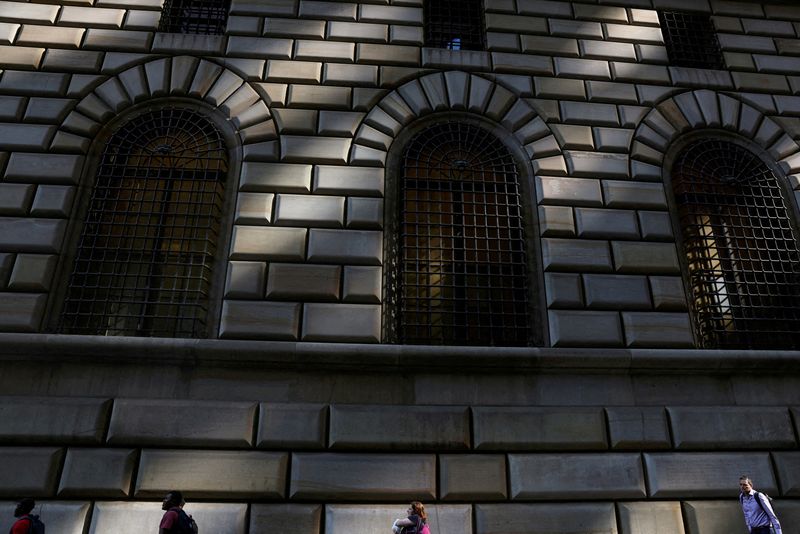By Michael S. Derby
(Reuters) – Wall Street’s biggest banks expect the Federal Reserve to end its balance sheet shrinking process in April next year, keeping pace with what it told the central bank in July have told.
Banks also expect the Fed’s balance sheet to bottom out at $6.4 trillion, well above the $4.2 trillion mark before the coronavirus pandemic hit in early 2020, according to a survey of so-called Primary Dealers, conducted by the New York Fed prior to the crisis. The interest rate-setting meeting of the central bank’s Federal Open Market Committee was held last month. These banks act as counterparties in Fed policy operations.
“Most dealers indicated they expected the end of the balance sheet reduction to be determined by reviews of reserve levels. [overnight reverse repo] withdrawal, or upward pressure on money market rates relative to government-administered rates,” the survey said. “Some dealers suggested that macro factors pose a risk to their prospects for the end of the runoff,” it added.
The publication of the study on Thursday follows the US central bank’s publication of the minutes of the September 17 and 18 FOMC meeting a day later. In that document, officials offered little new guidance on the balance sheet outlook, other than emphasizing the importance of communicating that the ongoing decline could continue even if officials cut the Fed’s interest rate target.
The latest Fed balance sheet news comes at a time when market participants are still eager for an unexpectedly turbulent end to the third quarter. The last trading day of September saw high short-term volatility and the first real-world use of the Fed’s Standing Repo Facility (SRF), although conditions have quickly returned to levels from before.
For just over two years, the Fed has been reducing its holdings of Treasury and mortgage bonds as part of a process called quantitative tightening (QT). That has taken total Fed investments from a peak of $9 trillion in the summer of 2022 to the current level of $7.1 trillion.
For much of the decline, QT has effectively tightened monetary policy, coupled with rate hikes by the Fed, as policymakers tried to curb high levels of inflation. But with price pressures easing significantly, the Fed last month cut its overnight target rate by half a percentage point, and for some markets that cast doubt on the need to continue with more balance sheet reduction.
WATCHING MONEY MARKETS
However, Fed officials have repeatedly said that what happens to the balance sheet is separate from interest rate policy, the main lever of monetary policy. Central bankers have also reiterated that balance sheet reductions will continue until excessive liquidity is removed from the financial system, although they are unsure when that point will arrive.
“Reserves are still plentiful and are expected to remain that way for some time,” Fed Chairman Jerome Powell said after the September meeting. “What that indicates is that we are not thinking about stopping the drain,” even if interest rates fall.
These expectations are being tested by money market conditions. On September 30, short-term rates were unexpectedly volatile and for the first time, market participants handed over a significant amount of eligible bonds to the Fed in exchange for cash at the SRF.
While at first glance this may seem similar to the events of September 2019, when the Fed ended its QT process due to interest rate volatility, in the current case the Fed has never lost control of the Fed Funds target rate as it did at the time.
The daily effective Fed Funds rate never fell from 4.83% last week – well within the current policy target of 4.75%-5.00% – while in 2019 it traded above the target range at the time. Last week, interest rates on open market overnight repo transactions with general collateral rose 9 basis points overnight, the highest level in about 11 months, but have since returned to about where they were.
Most analysts see the latest turbulence differently than they did five years ago.
“Last week’s interest rate spike was purely a result of constraints on dealer balance sheets rather than broader liquidity issues in the banking sector,” said analysts at Wrightson ICAP (LON:), adding that “reserve balances are within the range of over the past few years.”
Some market participants argue that tighter conditions in the repo market, where participants borrow and lend bonds, could prompt the Fed to end the QT relatively quickly.


The minutes of the meeting showed that Fed officials and staff responsible for monitoring the markets for signs of liquidity shortages were monitoring activity in the repo market.
While noting that market indicators pointed to still “abundant” reserves, the minutes pointed to higher repo market rates amid widespread government bond selling. The Fed official responsible for implementing monetary policy pointed out the links between the repo market and the federal funds rate, which “made clear the importance of monitoring a range of indicators to gauge reserve conditions and the state of money markets to be assessed,” the minutes say.

